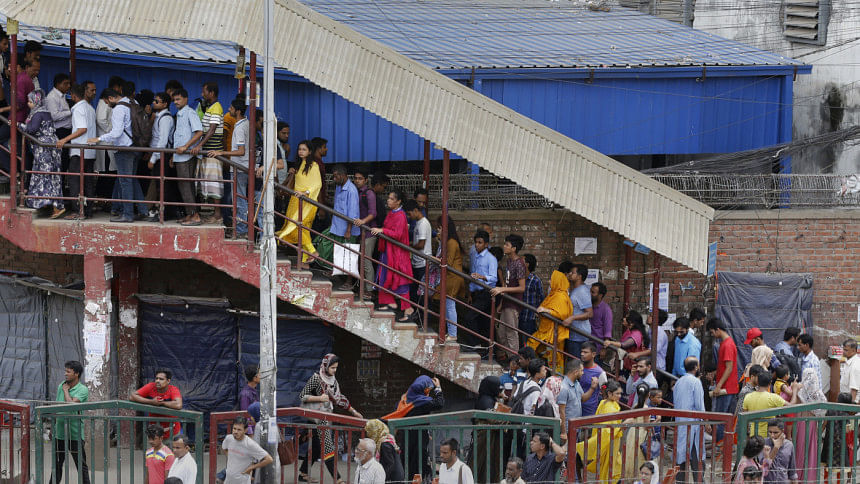Experiencing architecture around us

A space is more than a vicinity that shelters us. It morphs our emotions, helps our thoughts take shape, carves out a pathway to meet like-minded people, and creates communities. We spend a large fraction of our lives indoors, which impacts us in ways we don't even realise. Such is the pedigree of a discipline that is forged by culture and society. The application of architecture isn't merely to keep track of our physical footprints, it is a practice that is also meant to address our needs. By building on existing values and having them interweave with the contemporary, architecture, in turn, also shapes culture and society.
Whether to represent royalty, protect from harsh climates, or spark awe, architecture has always been emblematic of its time, location, and climate. Igloos are built with ice due to their low thermal conductivity and accessibility in the region. Japanese and Chinese architectural identities overlap due to their connection to Buddhism. The Taj Mahal utilises concepts of symmetry as well as rational and strict geometry to perpetuate the notion that Mughal leadership is flawless. A closer look at Dhaka and the parallels between the city and the livelihood of its people float to the surface. An urban jungle, lined with grey cement blocks as far as the eye can see. No corner is spared. Does it all stand to represent that people are trying to just get by? As morbid as this outlook might be, I am certain I am not the only one who bears it.
Nuren Iftekhar, a Dhaka University graduate currently working as a teacher abroad, shares his views. "Dhaka often feels like a canvas that different artists tried to paint on at the same time. A canvas that then got painted over by an amateur mason," he says. "Functionality has far outpaced the sense of beauty or cohesion. A walk through my area only shows apartments whose sole purpose is to hold as many people as the zoning board approves. Wide stretched balconies have been replaced by tiny alcoves with the sole purpose of drying clothes."

Rashed H. Chowdhury, the principal architect at Dehsarworks, highlights the significance of architecture on the zeitgeist. "A built environment is the result of all our collective effort and thoughts. While architects are the ones designing the spaces, they are responding to the needs of society. The projects also affect our conscious minds. The cause and effect go hand-in-hand."
"The primary identifier of any nation is its architectural landmarks, and I believe it is a visible envelope of our society," he said.
A building, even with its ornamental exterior and grand scale, is only as good as the amenities of the interior. If the space inside fails to fulfil its function, then by no means does it qualify as good design. By carefully curating the right forms, colours, shapes, light, and proportions, designers can influence how an occupant might feel.

"If anyone is stuck in a room that isn't exposed to natural light, has the same temperature throughout the day, and boasts no tangible change in the interior, it creates fatigue amongst its occupants," asserts Rashed.
Iftekhar recalls what stood out to him about the design of Curzon Hall, where he attended classes in university. "Perhaps the most noticeable aspect of Curzon hall was the uniformity. From the old halls to the newly established buildings, it is present everywhere. Even the Zoology building, with its separate colour scheme, felt like an extension of the original architectural vision. Any deviation from it feels jarring which is evident in the newer buildings. Despite having better accommodation, they never evoked the same feeling that Curzon hall did," he said.
Subah Shaheen, Manager at Robi Axiata Limited, discusses the use of symbolism in her workplace, "Our workplace has a great interior. There are words and icons dispersed throughout the walls on each floor, representing the core values, visions and objectives of the company. This not only reinforces what we hear in meetings and townhalls but is a constant reminder throughout the day about what we are trying to achieve and why."
There is evidence that using certain elements in the interior will evoke a specific kind of ambience and mood. Furthermore, a building serves a wide variety of needs of many different people. Even then, the space must serve more than one purpose for each individual Therefore, it really isn't feasible to predict how one might respond to their environment.
Iftekhar comments on how the architecture of Dhaka University and Curzon Hall makes him feel. "The first thing that Curzon hall evoked in my mind as I first stepped foot there as a freshman was grandeur. As cliched as it sounds, the wide hallway, the old arches and the red bricks gave it a sense of timelessness."
"Having a common space in every floor creates an opportunity for social interaction within the office. The space enables employees to have important discussions, enjoy a game of foosball, and does wonders to help relax during the day. It also helps us save time as you don't have to get out of the office to unwind," said Subah about her workplace.

New spaces must be designed to meet various needs. However, what appears to have taken precedence are economic benefits. Allowing capitalistic interests to dictate urban planning causes efficiency to trump empathy for the people. In the process, citizens are left stuck with a lack of open spaces, poorly designed footpaths, and a monotonous cityscape. Urban planners and policymakers must instil changes that account for the welfare of the people.
In a write-up for The Grudging Urbanist titled "There is just one way to save Dhaka", Adnan Zillur Morshed, renowned architect, architectural historian, and urbanist, attributed the capital's rampant traffic crisis to a lack of land-use planning. "We allowed the city to become an untenable urban juggernaut, an infernal urban agglomeration, paying little attention to how the city's land could be developed with a logical sequence of use and zoning," he says.
He urges that Dhaka undertake land-use planning – a system that opts for areas to facilitate schools, grocery shops, malls and other venues for recreation within walking distance of the residents. As a result, it will eliminate the need to travel long distances and reduce congestion within the city.
"I think what can really help the capital embrace openness is to first improve public transport. Discouraging the use of personal vehicles and harbouring collective commute is vital. It bunches people up and frees up space. The prospect of being a part of a community should be cherished and design should enable that. The fabric of the city should be people-centric," remarked Rashed.

Nonetheless, what plagues much of Dhaka is the invasion of open spaces. Footpaths are occupied, fields are a parading ground for local politicians, seasonal melas, or construction sites, and due to the steep climb in the rate of urbanisation, water bodies are at risk because of housing accommodations.
While it will generate employment in the tertiary sector, create new forms of income, and help the economy, this approach is myopic. Natural resources are compromised and historical landmarks are destroyed all for the sake of "development". What gets overlooked, as a result, are other problems that will have to be tackled in the future. If the correct measures are not taken now, the benefits of the present will merely be consolation.
An architect can let all the principles of design guide them but a design that is not centred around people is a design that will inevitably fail. Spaces are social spheres, grounds for igniting important conversations and inspiring change. A city that breeds unhappiness is a place that is waiting to fall apart. To nourish it is to let its inhabitants thrive. It is time we let consciousness spearhead architecture and design.
Rashed Chowdhury is hopeful about the future of architecture. He believes what allows it to thrive and makes it a promising field is the vastness, scope of innovation, geopolitical nature of Bangladesh and the spirit of youth.
"Unlike anywhere else in the world, Bangladeshi architecture incorporates a lot of diversity. Due to the reform having grey area, we are allowed to venture out and explore," he concludes.
Abir Hossain is a sub-editor at SHOUT, The Daily Star. Reach him at [email protected]

 For all latest news, follow The Daily Star's Google News channel.
For all latest news, follow The Daily Star's Google News channel. 








Comments